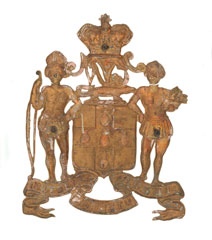
Online Collection
Helmet plate, Kingston Corps, Jamaica Volunteer Militia, 1890 (c)
A shield charged with a cross upon the centre with five pineapples. On each side of the shield a supporter; upon the right, a Jamaican male figure wearing a head-dress and holding a bow; upon the left, a Jamaican female figure holding a basket of fruit. Above the shield, a representation of a crocodile, surmounted by the entwined letters, 'KVM' (Kingston Volunteer Militia). Below all, a scroll bearing the motto, 'Indus Uterque Servietuni' (Both Indies will serve one). The whole surmounted by a monarchial crown.
The British raised militia forces across the West Indies during the seventeenth and eighteenth centuries to help defend the colonies from foreign attack but also to ensure internal security. During the pre-emancipation period militias were used to deter or counter slave revolts and to hunt down escaped slaves. The militias were predominantly white, drawing their recruits from small landowners, indentured servants and landless freemen.
During the French Revolutionary and Napoleonic period the recruitment of black troops increased to meet the threat to Britain's overseas territories. By 1805 the Jamaica Militia is believed to have numbered 10,000 foot and 1,000 horse. Militia units across the West Indies were subsequently incorporated into the West India Regiments.
The Jamaica Militia Infantry and the Jamaica Militia Artillery were raised in the last quarter of the 19th century. The Jamaica Militia Infantry was disbanded in 1906 with members forming the unofficial St Andrew Rifle Corps which became the Kingston Infantry Volunteers.
NAM Accession Number
NAM. 1970-12-117-1-6
Copyright/Ownership
National Army Museum Copyright
Location
National Army Museum, Study collection
Object URL
https://collection.nam.ac.uk/detail.php?acc=1970-12-117-1-6


